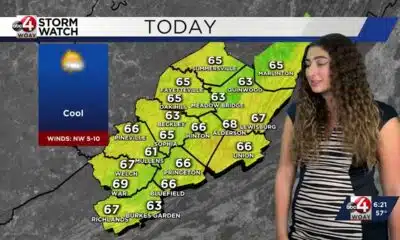News from the South - Louisiana News Feed
What to know about the U.S. House GOP’s student loan overhaul
by Shauneen Miranda, Louisiana Illuminator
May 15, 2025
WASHINGTON — Students and families could see significant changes to how student loans are repaid as well as cuts to federal student aid as congressional Republicans look to slash billions of dollars in federal spending to offset the cost of President Donald Trump’s sweeping agenda.
Republicans are using the complex reconciliation process to move a package through Congress with simple majority votes in each chamber, avoiding the Senate’s 60-vote threshold that generally requires bipartisanship.
The House Committee on Education and Workforce approved its portion of the package in a party-line vote in April, pushing GOP lawmakers a step closer to potentially securing key changes to student loan repayment options and Pell Grant eligibility.
Chairman Tim Walberg, a Michigan Republican, said the 103-page bill would save taxpayers more than $350 billion over 10 years and “bring much-needed reform” on “simplified loan repayment, streamlined student loan options, and accountability for students and taxpayers.”
But the bill has drawn criticism and worry from student advocates and congressional Democrats over how the proposed changes would impact higher education affordability and access.
Aissa Canchola Bañez, policy director at the Student Borrower Protection Center, told States Newsroom that the advocacy group was “really troubled to see House Republicans take such a drastic approach to their efforts to address the college affordability crisis.”
“Unfortunately, this bill will make college more expensive for families and students and will make it significantly more risky for students and families just trying to pay for college, and it’s also going to make student loan debt significantly more expensive for millions of borrowers across the country,” she said.
Rep. Bobby Scott, ranking member of the committee, echoed the concerns of student advocacy groups.
The Virginia Democrat said the bill would “increase costs for colleges and students,” “limit students’ access to quality programs” and take “all the so-called ‘savings’ to pay for more tax cuts for the wealthy and the well-connected.”
Here’s a breakdown of some of the major changes outlined in the House education panel’s portion of the package:
The bill would repeal subsidized loans — where the federal government pays the interest on the loan while a borrower is in school — for borrowers beginning July 1, 2026, according to the committee’s summary.
For unsubsidized loans disbursed on or after July 1, 2026, the maximum annual loan limit would be amended to the “median cost of students’ program of study.”
The total amount of federal student aid a person could receive annually would also be capped at the “median cost of college.” According to the committee, this is defined as “the median cost of attendance for students enrolled in the same program of study nationally and calculated by the (Education) Secretary using data from the previous award year.”
Aggregate limits, or the maximum amount a student can borrow, would cap at $50,000 for undergraduate programs; $100,000 for graduate programs; and $150,000 for professional programs, such as law or medical school.
The bill also repeals the Grad PLUS program and places new restrictions on Parent PLUS loans.
Undergraduate students would be required to “exhaust their unsubsidized loans before parents can utilize Parent PLUS to cover their remaining cost of attendance,” according to the panel’s summary.
Canchola Bañez noted that the repeal of the Grad PLUS program would increase the likelihood that students would have to take out loans in the private market to fill gaps they would have normally filled by using Grad PLUS loans.
“We know that private loans have much less protections and consumer protections for borrowers,” she said, adding that “the more we push folks out of the federal market and into the private market, the less students and borrowers have access to those protections should things go wrong after school.”
‘Skin-in-the-game accountability’
The package also proposes “skin-in-the-game accountability” for colleges and universities, and institutions would have to pay the federal government “a percentage of the non-repayment balance associated with loans disbursed on or after July 1, 2027,” according to the panel’s summary.
Preston Cooper, senior fellow in higher education policy at a right-leaning think tank, the American Enterprise Institute, said “essentially, for colleges whose borrowers require some of this repayment assistance, if their payments are too low to cover interest on their loans, or they require that principal credit, the colleges will have to cover a share of the costs.”
“They won’t have to cover all the costs — the government will pay some of it — but they will have to cover some of the cost of providing borrowers with that repayment assistance, and I think the idea here is to create better incentives for colleges to make sure that they’re not loading students up with unnecessary debt,” he said.
Pell Grant eligibility
The bill redefines full-time enrollment for Pell Grants — a federal government subsidy that helps low-income students pay for college.
The legislation raises the minimum number of credit hours to qualify for the maximum Pell Grant award from 12 credit hours per semester to 15 credit hours. Students would also be ineligible for a Pell Grant if their Student Aid Index — a formula-based number to determine financial aid eligibility — equals or surpasses twice the amount of the maximum Pell Grant.
Pell Grant eligibility would also be expanded for those in short-term programs between eight and 15 weeks long.
Repealing the SAVE plan
The bill creates just two repayment plans — a Standard Repayment Plan and a Repayment Assistance Plan, while eliminating the Biden administration’s Saving on a Valuable Education, or SAVE, plan, which is currently tied up in federal court.
The Standard Repayment Plan includes fixed monthly payments and repayment terms between 10 to 25 years depending on how much one borrows, per the committee, while the Repayment Assistance Plan calculates payments based on a borrower’s total adjusted gross income.
The Repayment Assistance Plan also includes a minimum $10 monthly payment and “offers balance assistance to borrowers making their required on-time payments by waiving unpaid interest and providing a matching payment-to-principal of up to $50,” according to the panel.
Cooper said the Repayment Assistance Plan “fixes one of the long-standing problems in the income-driven repayment system for student loans, which is that a lot of borrowers’ payments don’t cover their accrued interest, which means that they see their balances rise over time.”
Louisiana Illuminator is part of States Newsroom, a nonprofit news network supported by grants and a coalition of donors as a 501c(3) public charity. Louisiana Illuminator maintains editorial independence. Contact Editor Greg LaRose for questions: info@lailluminator.com.
The post What to know about the U.S. House GOP’s student loan overhaul appeared first on lailluminator.com
Note: The following A.I. based commentary is not part of the original article, reproduced above, but is offered in the hopes that it will promote greater media literacy and critical thinking, by making any potential bias more visible to the reader –Staff Editor.
Political Bias Rating: Center-Right
The content is reporting on the proposed changes to federal student aid and loan repayment options under Republican-led efforts, focusing on how these changes align with President Trump’s agenda. The tone is mostly factual but highlights both Republican claims of cost-saving reforms and Democratic concerns about increased costs for students. The inclusion of statements from right-leaning and left-leaning sources provides a balanced representation of the issue, though the framing of the proposed changes as “drastic” and detrimental to students’ financial well-being suggests some opposition to the policy from those critical of Republican proposals. Overall, the article maintains a neutral stance but leans slightly towards a conservative perspective, emphasizing the Republicans’ intent to streamline and reduce government spending.
News from the South - Louisiana News Feed
Since Katrina, infrastructure shortcomings create resiliency fatigue
by Elise Plunk, Louisiana Illuminator
August 26, 2025
An American flag has been strategically placed on one of the massive beams supporting the Lake Borgne Surge Barrier, part of the New Orleans region hurricane and storm damage risk reduction system.
Completed in 2009 to close off the Mississippi River Gulf Outlet, the barrier is designed to decrease damage to the metropolitan area when a major hurricane pushes water from the Gulf of Mexico into the lakes that surround the city and neighboring parishes.
The flag on the wall symbolizes pride and mourning, a reminder of the people it protects and a memorial for those who died 20 years ago when Hurricane Katrina hit. The failure of the federal levee system Aug. 29, 2005, claimed more than a thousand lives, displaced nearly a million people in the region and left permanent scars on New Orleans.
A go-to term emerged to praise New Orleanians and their neighbors who persevered through the catastrophe and took part in the unprecedented rebuilding: resilient. But as various recovery programs faltered and efforts to ensure disaster history would not repeat itself stalled, “resilient” or “resiliency” now elicit bitter feelings among locals.
“I think people have gotten tired of the word. Not just because it’s become cliché, but because people have begun to understand it as an excuse for lack of preparation or execution, lack of planning or execution,” said Michael Hecht, CEO and president of Greater New Orleans Inc., a regional economic development group.
Hecht came to Louisiana in 2006 from New York, where he led a 9/11 small business recovery program for New York Mayor Michael Bloomberg. After directing the state’s post-Katrina business recovery efforts, he was chosen to lead GNO Inc. in 2008.
“We had been knocked down by an unprecedented event,” Hecht said. “It was either be resilient or die, so we were resilient.”
The world has watched as New Orleans fundamentally changed, having lost a significant portion of its Black working class and attracting an upsurge in mostly white transplants from out of state. With more than 484,000 residents before Katrina, the city’s population plummeted below 344,000 in the 2010 census. The number climbed above 391,000 in 2020 and has since fallen about 4% as of 2024, according to various estimates.
Most who have stayed are ardent defenders of the city’s culture, of which resiliency fatigue is quickly becoming a feature. It’s reflected in Louisiana’s slow progress to rebuild coastal land and improve the adaptability of cities to match what post-Katrina boosters envisioned.
GET THE MORNING HEADLINES.
Restoration resistance
After Katrina, more emphasis was placed on rebuilding Louisiana’s vanishing coastal wetlands to protect residents from the increasing threat of hurricanes. A state Coastal Master Plan has taken shape over the past two decades, gaining official approval in 2023, to tie together restoration efforts and shield wetlands from sea level rise, subsidence and worsening hurricanes.
“We learned from Hurricane Katrina that levees alone aren’t enough,” said Alisha Renfro, a coastal scientist with National Wildlife Foundation. “We also need a healthy natural ecosystem sitting out in front of those levees to protect the structures that protect our communities.”
But the master plan encountered a huge setback in July with the end of what had been its keystone project, the Mid-Barataria Sediment Diversion project. Gov. Jeff Landry led pushback against the project for its feared impact on fisheries and nearly $3 billion price tag.
So far, the state’s Coastal Restoration and Protection Authority has spent $600 million to harness the power of the Mississippi River to bring fresh water and sediment to wetlands in the Barataria Basin – only to shelve the diversion.
“It was probably one of the most innovative, forward-thinking things in terms of being a resilience hub for the world,” said Amanda Moore, senior director for the National Wildlife Federation’s Gulf program.
A lifetime Gulf Coast resident, Moore moved to New Orleans from the Tampa, Florida, area in 2009 to take a job as a community organizer with the National Wildlife Federation. She joined the wave of thinkers, scientists and planners who came to the city after Katrina with the hope of bringing relief from the constant threat of flood.
“For people who live on the Gulf Coast – and especially South Louisiana – it’s exhausting,” she said.
The federation was among the voices that influenced upgrades to the region’s storm risk reduction system in the years after Katrina. Moore led efforts such as the MRGO Must Go Coalition, advocating for reversal of wetlands damage attributed to saltwater intrusion from the Mississippi River Gulf Outlet.
“You’re helping to alleviate maybe some of that exhaustion that people are personally feeling when you do the coastal restoration,” Moore said. “You’re adding this layer of protection, you’re helping it create a healthier environment that’s safer, so that does help people really be more resilient and not burnt out.”
Funding momentum peters out
As Katrina and its aftermath garnered worldwide attention, the recovery money streamed in from Washington and charitable foundations. The federal government directed $76 billion to Louisiana projects.
But keeping up the pace of investment after post-disaster attention spans waned became a problem for state and local leaders. Even with billions of dollars put into infrastructure, billions more would be needed for upkeep and replacing outdated systems. Stormwater drainage and drinking water in New Orleans, for example, rely on a power supply and mains that, in many spots, are more than a century old.
Charles Allen, Gulf Coast community engagement director for the National Audubon Society, recalls the vast amounts of federal and philanthropic dollars directed to the region in the years immediately after Katrina – and the dropoff that followed. It revealed the inability of state and local governments to sustain the level of rebuilding needed.
“It’s like anything in life, you know?” Allen said. “We gotta maintain our bodies, and we have to invest in whatever it takes to do that.”
The 2010 explosion of the Deepwater Horizon just off the Southeast Louisiana coast reopened wounds in the region that had yet to heal from Katrina’s trauma. Like the levee failures after the hurricane, It was considered another manmade, preventable disaster. Eleven crew members were killed, and the catastrophic oil spill tainted wildlife and habitat in all five Gulf Coast states. Livelihoods that depended on the Gulf were sidetracked for months, if not ended entirely.
Petroleum giant BP, which contracted the drillship, reached a $20 billion settlement with the federal government and impacted states. In Louisiana, it provided the long-sought financial foundation for its coastal master plan.
But with the Mid-Barataria Sediment Diversion shelved – and seemingly no other major restoration projects in the queue – Allen and others with vested interest in coastal flood protection fear Louisiana has become dependent on disaster recovery funding to pay for critical infrastructure that should already be in place.
“Let’s not wait for another storm because then it’s always too late when that happens,” Allen said “You gotta invest in it, you gotta support it, you’ve got to fund it.”
“It’s a lot of reactive disaster-related funding that’s allowing Louisiana to do this work,” Moore said. “We’ve got to figure out how to get out of that cycle.”
‘People can just be people’
Katrina recovery funds paid for upgrades to the massive pumping stations at the end of New Orleans’ outfall drainage canals that pump stormwater into Lake Pontchartrain. Beyond that, however, the city hasn’t engineered a way to handle street flooding from routine heavy rainstorms.
One project was held up as a way for New Orleans to adapt to the regular influx of rainwater, rather than fruitlessly attempt to pump it away. The Gentilly Resilience District called for turning neutral grounds in the neighborhood into retention areas. Residents would be encouraged to add features such as rain cisterns and permeable driveways, with grants to cover their cost.
The centerpiece of the district was the Mirabeau Water Garden, planned for 25 acres of land that were once home to a Catholic convent. The Congregation of the Sisters of St. Joseph donated the land to the city in 2015 on the condition it be used to enhance and protect the neighborhood. It was designed to divert and hold up to 10 million gallons of stormwater in ponds and constructed wetlands, with a pedestrian path and other amenities to invite the public into the space.
The architecture firm Waggonner and Ball designed the water garden using best practices for how to integrate water into a coastal urban setting. The idea came out of a trans-Atlantic collaboration after Katrina called the Dutch Dialogues, in which New Orleans experts tapped into the Netherlands’ experience living with water.
The federal government provided $141 million to the city in 2017 to bring the Gentilly Resilience District to life, with a completion date set for September 2022. But as of 2023, the U.S. Department of Housing and Urban Development noted that only 15% of the money had been spent. The water garden remains largely unfinished.
HUD’s inspector general designated the city a “slow spender” in a project audit, noting that its elements “did not always improve the program participants’ ability to withstand future extreme events.”
In addition to his role with GNO Inc., Hecht was named chairman of the governor’s committee to prepare New Orleans for the 2025 Super Bowl, played in February at the Superdome. Part of Hecht’s charge was to track progress on city infrastructure projects. And while the Gentilly Resilience District is well outside the city’s tourist zone, its lack of progress was noticeable.
“It’s happening. It’s been accepted as a concept, but it’s been extremely slow,” Hecht said. “And that’s just been execution failure, oftentimes on the part of the city.”
The communications team for the city of New Orleans did not respond to a request for comment on the timeline of finishing the Mirabeau Water Gardens.
The Mirabeau Water Garden’s status is considered by residents to be symbolic of New Orleans falling well short of the post-Katrina vision that boasted resilience as a key component of its new economy. Much like the Netherlands, it was thought that the Crescent City could become a beacon of expertise for how to adapt to climate change.
“We thought we were going to be able to really build a sector around selling our experience post Katrina with water management and environmental management around the world,” Hecht said. “If we’re being honest, it has not materialized much as part of our economy.”
It has happened in a small way, he said, citing the Water Institute in Baton Rouge. The independent research center focuses on the Mississippi River Delta and Gulf Coast, and it has applied its expertise to several projects in the region.
“But I think there’s still a lot more,” Hecht said.
Allen believes the opportunity to make Louisiana that hub of water management and resilience still exists, but he acknowledged it is still far from materializing 20 years after Katrina.
“This story of restoration, it’ll never end, which is a good thing,” Allen said. “This kind of work fuels jobs, environmental research and teaching.”
Until or unless that sector develops, the vulnerability of southeast Louisiana to future disasters will continue to place a strain on its residents, observers say, and climate change only heightens that risk.
“That is the goal … building structures, either literally or metaphorically, strong enough so that in a world with climate change and weather volatility, when things happen, either natural or man made, we don’t have to be resilient,” Hecht said.
Renfro, the coastal scientist with the National Wildlife Federation, said it’s wrong to keep placing the same burden of recovery on a population forced to accept conditions beyond their control.
“Asking the same people again and again to be resilient … it feels unfair,” she said. “People can just be people, and infrastructure can be resilient.”
YOU MAKE OUR WORK POSSIBLE.
Louisiana Illuminator is part of States Newsroom, a nonprofit news network supported by grants and a coalition of donors as a 501c(3) public charity. Louisiana Illuminator maintains editorial independence. Contact Editor Greg LaRose for questions: info@lailluminator.com.
The post Since Katrina, infrastructure shortcomings create resiliency fatigue appeared first on lailluminator.com
Note: The following A.I. based commentary is not part of the original article, reproduced above, but is offered in the hopes that it will promote greater media literacy and critical thinking, by making any potential bias more visible to the reader –Staff Editor.
Political Bias Rating: Center-Left
This content primarily focuses on the environmental, social, and governmental challenges faced by New Orleans post-Hurricane Katrina. It highlights the shortcomings of government and infrastructure in adequately preparing for and responding to disasters, emphasizes the need for investment in sustainable and natural coastal restoration efforts, and discusses social issues like demographic changes and economic recovery. The article critiques political and administrative decisions, such as the shelving of major restoration projects and slow spending of federal funds, from an angle that favors proactive climate resilience, environmental protection, and equitable recovery efforts—stances typically associated with center-left perspectives. However, it avoids overt partisanship or ideological rhetoric, maintaining a fact-based and nuanced approach.
News from the South - Louisiana News Feed
Monday Noon Tropics Update: Fernand heads north, Invest 99 fizzles
SUMMARY: Tropical Storm Fernand is improving in organization with 60 MPH winds but faces increasing wind shear and cooler waters as it moves north, likely weakening by Wednesday without threatening land. Invest 99 in the eastern Caribbean remains disorganized with strong wind shear, leading the National Hurricane Center to drop its development chance to 0%. The hurricane season has reached Fernand, with Gabrielle and Humberto next on the list, though no new formations are expected soon. Approaching the peak hurricane season around September 10, activity is likely to continue through September, with cooling temperatures and increased rain chance as fall approaches.
Meteorologist Alexandra Cranford tracks Tropical Storm Fernand and Invest 99 at noon on Monday, August 25, 2025.
News from the South - Louisiana News Feed
Fox 14 Your Morning News: Movement Monday
SUMMARY: Fox 14 Your Morning News’ Movement Monday features partner exercises focused on fun and fitness. The segment includes reverse lunges, one-legged squats, and partner high-five squats to build strength and balance. They use a ball or pillow for back-to-back seated twists and tossing exercises to engage the core. The workout ramps up with side-to-side knee kicks and ab work to boost abdominal strength. Lastly, partners perform planks combined with cardio moves like jumping through feet, emphasizing proper form, breathing, and rhythm to maximize calorie burn and stability. The lively, encouraging approach makes fitness enjoyable and accessible.
Amy returns for another lively installment of ‘Movement Monday,’ which includes a variety of exercises such as reverse lunges, one-legged squats, and planks, all aimed at promoting fitness and teamwork.
-
News from the South - Alabama News Feed7 days ago
U.S. agriculture secretary announces end to subsidies for solar panels on farmland
-
News from the South - Kentucky News Feed6 days ago
First of its kind clinical trial offers new hope for Kentuckians at risk of dementia
-
News from the South - Arkansas News Feed7 days ago
Cities across the US are embracing AI guidelines for local government workers
-
News from the South - Alabama News Feed6 days ago
Grants to boost local emergency alert systems in question as public media agency closes
-
News from the South - Georgia News Feed7 days ago
Don't eat this shrimp sold at Walmart due to possible radiation contamination: FDA
-
Our Mississippi Home6 days ago
MSU Unveils Mixed-Use Development Featuring Boutique Hotel, Cultural Landmark
-
News from the South - Arkansas News Feed6 days ago
‘Alligator Alcatraz’ probed by Dems as ICE detention centers multiply in states
-
News from the South - Arkansas News Feed5 days ago
New I-55 bridge between Arkansas, Tennessee named after region’s three ‘Kings’











































